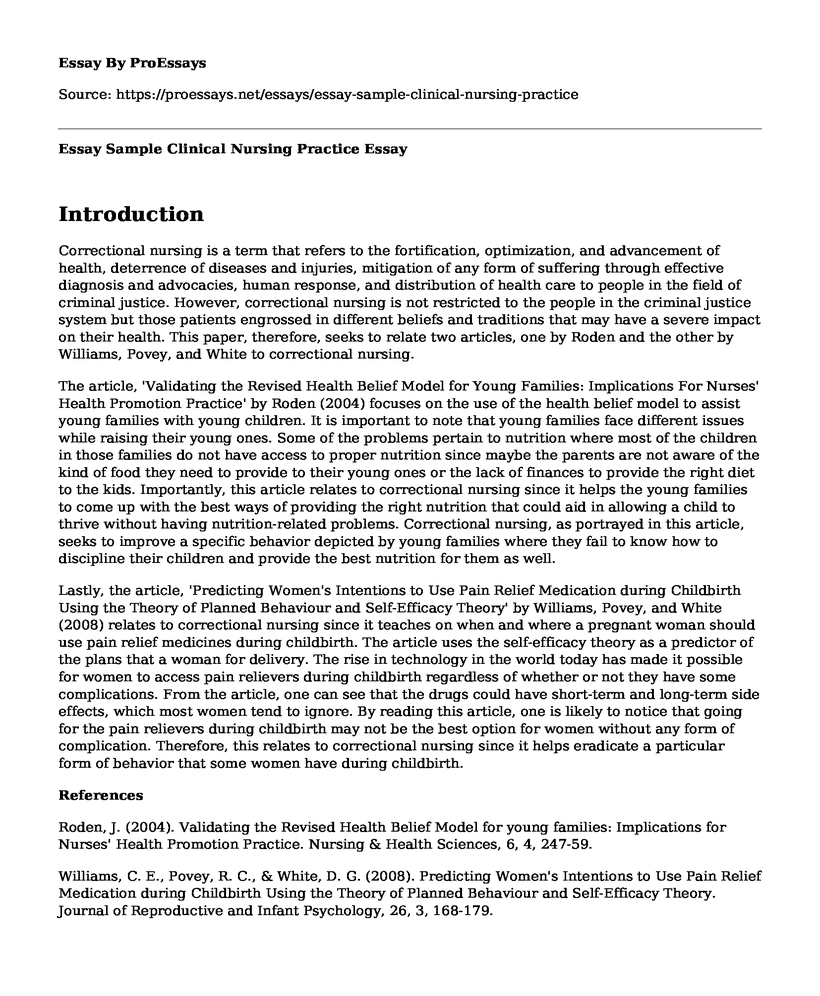Introduction
Correctional nursing is a term that refers to the fortification, optimization, and advancement of health, deterrence of diseases and injuries, mitigation of any form of suffering through effective diagnosis and advocacies, human response, and distribution of health care to people in the field of criminal justice. However, correctional nursing is not restricted to the people in the criminal justice system but those patients engrossed in different beliefs and traditions that may have a severe impact on their health. This paper, therefore, seeks to relate two articles, one by Roden and the other by Williams, Povey, and White to correctional nursing.
The article, 'Validating the Revised Health Belief Model for Young Families: Implications For Nurses' Health Promotion Practice' by Roden (2004) focuses on the use of the health belief model to assist young families with young children. It is important to note that young families face different issues while raising their young ones. Some of the problems pertain to nutrition where most of the children in those families do not have access to proper nutrition since maybe the parents are not aware of the kind of food they need to provide to their young ones or the lack of finances to provide the right diet to the kids. Importantly, this article relates to correctional nursing since it helps the young families to come up with the best ways of providing the right nutrition that could aid in allowing a child to thrive without having nutrition-related problems. Correctional nursing, as portrayed in this article, seeks to improve a specific behavior depicted by young families where they fail to know how to discipline their children and provide the best nutrition for them as well.
Lastly, the article, 'Predicting Women's Intentions to Use Pain Relief Medication during Childbirth Using the Theory of Planned Behaviour and Self-Efficacy Theory' by Williams, Povey, and White (2008) relates to correctional nursing since it teaches on when and where a pregnant woman should use pain relief medicines during childbirth. The article uses the self-efficacy theory as a predictor of the plans that a woman for delivery. The rise in technology in the world today has made it possible for women to access pain relievers during childbirth regardless of whether or not they have some complications. From the article, one can see that the drugs could have short-term and long-term side effects, which most women tend to ignore. By reading this article, one is likely to notice that going for the pain relievers during childbirth may not be the best option for women without any form of complication. Therefore, this relates to correctional nursing since it helps eradicate a particular form of behavior that some women have during childbirth.
References
Roden, J. (2004). Validating the Revised Health Belief Model for young families: Implications for Nurses' Health Promotion Practice. Nursing & Health Sciences, 6, 4, 247-59.
Williams, C. E., Povey, R. C., & White, D. G. (2008). Predicting Women's Intentions to Use Pain Relief Medication during Childbirth Using the Theory of Planned Behaviour and Self-Efficacy Theory. Journal of Reproductive and Infant Psychology, 26, 3, 168-179.
Cite this page
Essay Sample Clinical Nursing Practice. (2022, Nov 25). Retrieved from https://proessays.net/essays/essay-sample-clinical-nursing-practice
If you are the original author of this essay and no longer wish to have it published on the ProEssays website, please click below to request its removal:
- Patient Teaching Plan for Type 1 Diabetes Essay
- Should Smoking in the Public Be Allowed? - Essay Sample
- Proposal to Reduce Organ Shortage and Curb the Organ Black Market
- Unlocking My Unique Walking Style to Learn New Moves - Essay Sample
- Essay on Promoting Self-Cannulation: Applying Watson's Theory of Caring to End-Stage Renal Disease
- Essay Example on Modern Health Care: Neglect of Nursing Management?
- Theory-Research-Practice Link: Key to Successful Evidence-Based Nursing - Essay Sample







